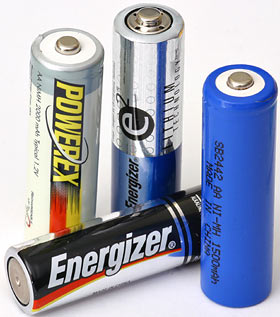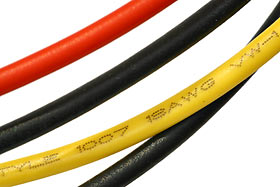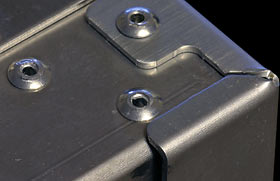
Atomic I/O letters column #30
Originally published in Atomic: Maximum Power Computing Reprinted here February 2004. Last modified 16-Jan-2015.
Ni-Cads Of Doom
I've been wondering about the reliability and safety of using rechargeable batteries instead of regular alkaline varieties. Over the years I've come across products that state on the back "do not use rechargeable batteries".. Some of those happily worked for years using only rechargeables, some would fry the moment you switched them on with rechargeables in them (such as a lot of older pocket TVs). Some products say to use only NiCad and not NiMH, or vice versa.
It certainly seems like a lot of recommendations are made by companies that also have their own branded alkaline batteries (Sony, Panasonic etc), so it's very likely they would prefer you to buy regular batteries (their own brand, preferably).
Is there was a way to know for certain that it is safe to use a particular battery type?
Steve

Lithium, alkaline, NiMH - decisions, decisions...
Answer:
The usual reason for sudden gadget death caused by rechargeables is that
the device expects batteries with fairly high internal resistance. It's
using that resistance as part of (or all of...) its power-supply current
limiting.
Non-rechargeable batteries (carbon zinc, alkaline, and the not-very-popular rechargeable alkaline) have their own resistance to the flow of current, which is generally a bit less than half an ohm, for an alkaline AA cell ("cell" is the technically correct term for one electrochemical unit; "batteries" are technically two or more cells put together). This means that even if you short-circuit an alkaline AA, only a few amps of current will flow - and that'll fall rapidly, as the poor cell heats up, its internal resistance rises, and its terminal voltage plummets.
Nickel cadmium (NiCd) and nickel metal hydride (NiMH) rechargeable cells have internal resistance too, but it's much lower; well under 0.1 ohms, even for AAs. You wouldn't think this'd be too much of a problem, since the terminal voltage for these chemistries is only 1.2 volts per cell, versus 1.5 volts per cell for non-rechargeables. Less voltage, less current. But problems can still arise with gadgets that draw a lot of current, and with rechargeables that're freshly charged.
Freshly charged cells will have a terminal voltage well above their nominal potential; fast-charged NiMH can easily manage 1.4 volts per cell, right out of the charger. If a device expects less than that (because it draws a lot of current and thus causes fresh alkaline cells to sag to, say, 1.3 volts), the combination of high terminal voltage and low internal resistance can allow much more current to flow than is meant to. Result: Fried gadget.
The same thing can, by the way, happen if you use lithium AA cells in some devices. Lithiums have a 1.7 volt per cell nominal potential, and don't sag as much under load as alkalines.
You can almost always avoid the death-by-NiMH problem by simply letting your rechargeables stand overnight after charging them, so their terminal voltage settles down. Some devices still need the internal resistance of non-rechargeables, though.
NiCd has lower internal resistance than NiMH, but "peaks" lower after charging as well, all things being equal. So it's possible that some gadgets may actually prefer one technology over the other. This is pretty darn abstruse, though; generally, if something works with one rechargeable chemistry, it'll work with the other.
Wire hunter
A few months ago, Atomic ran a series of articles demonstrating a top-to-bottom "case mod" job, including the installation of a "wiring pole" to conceal all those messy black, yellow and red wires.
I'm keen to build a similar custom wiring harness for my PC to maximize neatness.
Gathering parts for this job has been easy up to a point; Jaycar can supply the needed plugs and sockets as well as the crimping tool and die set. Wire, on the other hand, is being difficult to find! All I'm looking for is a supply of wire to match the colour and characteristics (conductor gauge and insulation thickness) of the wire used to make the leads attached to your average PC power supply. In my search, I've tried electronics stores, hardware stores, electrical wholesalers and car accessory outlets - no luck!
Short of ordering from wire manufacturers in the USA, I thought I'd write and ask to see if you knew of any Australian suppliers of the type of wire I'm after.
Rob

A lot of wire helpfully has its AWG number printed on it.
Answer:
You won't necessarily be able to match it precisely, but since it's
all likely to be cheap 16AWG (American Wire Gauge) and 18AWG PVC-insulated
stuff, it's not very hard to duplicate. Medium to heavy duty hook-up wire,
with the same cross-sectional area of copper or a bit more, will do the
trick. If you want to be able to route the wire around tight corners, look
into more expensive silicone-insulated wire, which is commonly available
for thrillingly high prices from hobby shops (R/C modellers use it because
of its flexibility and heatproof insulation). Most electronics stores don't
stock "silicone wire", but better automotive suppliers might.
The silicone insulated wire will probably have a lot more strands, and they'll be a lot finer; the total amount of copper in there will be the same as you'd get from cheap wire of the same gauge, but the finer strands make the wire more flexible and less likely to fracture.
If you don't care about this, though, then just buy cheap PVC insulated hook-up wire a little thicker than what's coming out of the PSU already, and you'll be fine. Hook-up wire comes in plenty of colours, so there's a good chance you'll be able to match the colour of every wire from the PSU.
Surround 'phones?
I'm planning to upgrade my PC speakers, and I'm thinking of buying a good set of headphones instead. I've read that headphones are better than speakers for 3D positional sound. Headphones seem to be better in terms of telling whether the sound is from the left or right, but what about telling the front-back location of the sound? Are headphones equal to or better than 4.1 or 5.1 speakers in this regard?
My type of games are of the first-person "sneak-shooter" type like Thief, and positional sound is very important for me. What do you suggest?
Michael
Answer:
Headphones are better for all aspects of 3D audio, provided they're being
fed by a sufficiently clever positional audio algorithm, and it in turn
isn't being fed dumb data by the game you're playing.
On the face of it, this seems silly. Obviously, speakers behind you should be the best at making you think there's a noise behind you, because, you know, there is.
But you only have two ears, on the sides of your head. You don't have any extra fore-and-aft sensors. Your ears figure out where a sound source is by using the oddities of the reflections and occlusions from the pinnae (the external cartilaginous ear parts whose other primary function is to give kidnappers something to cut off and mail to show they're serious), and positional audio systems use Head Related Transfer Functions (HRTFs) to fake the effects that the pinnae have on sounds from different places, so that a transducer firing straight into the ear from the side can make itself sound as if it's somewhere else.
Stereo surround speakers can do the same job with less processing, but they won't necessarily, and they're also likely to have pretty lousy drivers in them (if they're the usual kind of PC satellite speakers). All speaker systems also have channel separation problems; extra processing has to be done to minimise the amount of left-ear signal the right ear hears, and vice versa. Headphones have very little crosstalk between channels, so it's much easier for the HRTF-twiddled audio to be delivered only to the ear to which it's meant to go.
So I think you'll prefer headphones. Make sure, however, that you get comfortable headphones, since you're likely to be wearing them for a long time. Go to a hi-fi store that'll let you try on various different 'phones, and do so.
I, and a lot of other people, like around-the-ear 'phones, with big oval pads that sit around the pinna, not on it. I'm using a set of Sennheiser HD590s, for this reason; they're medium-expensive 'phones, but they're still cheap compared with a good surround speaker system.
Upgrade quandary
I recently suffered a motherboard meltdown. The board was a Gigabyte GA-7VRXP Rev 2.0, and was still under warranty. The supplier that I bought it from doesn't stock them any more, and I've been looking for an alternative if they can't get another one.
I've been looking at the Gigabyte GA-7N400 Pro (I'd prefer an MSI board, but the supplier doesn't stock them). I have two reservations about it.
The Gigabyte site states that the board will only accept 1.5v AGP cards. I have a MSI Geforce4 Ti4400, but try as I might, I have been unable to find what voltage the card uses. I checked the manual for the GA-7N400 board, and the image on the first page of the 1.5v and 3.3v notches on the card match up with the notches on my card, but I'm not entirely sure if it will work.
The second problem isn't nearly as bad. The GA-7N400 uses Dual Channel DDR RAM, and I have only one DIMM. I'm pretty sure that it will work fine, but I'd like another opinion. The last thing I want to do is put my PC back together again and find that I need to buy another 512Mb RAM.
Lastly, I will need to re-apply some thermal paste to the heatsink. I'm going to use Arctic Silver III. My heat sink has one of those thermal pads, and has been in use for about 6 months, running almost 24/7. The Arctic Silver web site says that these pads should be removed before being used, as when the heatsink is used, the pad will melt into the microscopic grooves. Should I purchase a new heatsink and scrape off the pad, or can I use my current heatsink after cleaning the CPU and heatsink with Zippo fluid, and expect the Arctic Silver III to do its job well, but without optimum results due to the bits of thermal pad I just can't get out?
Jason
Answer:
Your GeForce4 uses 1.5V signalling (its power supply is 3.3 volts, but its
logic interface is 1.5). Everything capable of AGP 4X or better is a 1.5V
card. So that's not a problem.
The GA-7N400 will also work fine with just one memory module - just not in dual channel mode. NForce 2 boards allow dual channel mode if you've got two memory modules, and also if you've got three or four, provided you follow the mildly obscure rules for single and dual banked three and four module layouts that're described in the manual.
Running in single channel mode creates a measurable performance hit, but not one that you should lose sleep over; it'll be no slower than your old board was.
"Chewing gum" thermal compound is, as you say, single-use only. (Although, in a pinch, you generally can re-use it; you just don't get a very good thermal contact between the heat sink and the processor. It'll probably do, at stock CPU speed and with the side off the case, for a day or so until you can buy yourself some more goop.)
After cleaning with the nasty solvent of your choice (or just dishwashing detergent and some elbow grease), your old heat sink will be as good as a new one. Thermal goop manufacturers like to bang on about microscopic intergranular penetration, blah blah, but in the relatively high-tolerance world of the spring-attached CPU heat sink, a mild gloss of old goop molecules makes no real difference.
Riveting!
I plan to build a new system for myself as a Christmas/graduation present, and it's going to be water cooled. The exact details, save one, are fairly unimportant.
That detail is my desire to use a radiator that'll take at least one 120mm fan, such as one of the Black Ice Xtreme line.
And, of course, as befitting a water cooled top-of-the-line PC system with cold-cathodes, disco balls, little statues, flaming exhaust pipes, etc, I'd like to put the innards into something more than a little beige monstrosity.
While looking at Lian Li cases, I was impressed by everything save the top panel. It seemed welded on... and to mount a radiator with multiple 120mm fans, I'd need to do some Dremelling. Right now I've got my system's guts in a Koolance PC-2C and rather like that arrangement.
Is it a feasible to detach the top panel from a Lian Li case, or the Cooler Master equivalent? I don't want to be popping out rivets if at all possible, as my skill with the Dremel leaves much to be desired.
If I were to give up my shiny aluminium dreams and settle for one of those acrylic cases, how hard is that stuff to machine with common tools (drill, circular saw, jigsaw, hammer, plethoras of curse words, etc)?
Piloter
Answer:
The non-removable Lian Li panels aren't welded - they all just use pop rivets,
as far as I know.
Pop rivets are easier to remove than you think; they're only aluminium, and you get rid of them by drilling into the head until it comes loose (turning into a little collar spinning around on your drill), then knocking the stem through the hole with a punch.
(If you left your lovely set of fractional pin punches in your other pants, you can just use a nail.)
With the rivets gone, you can remove the panel and do whatever you want to it, then replace it and pop in new rivets. Pop rivet setters are available pretty inexpensively from every half-decent hardware store, and the rivets are dirt cheap. Or you can bolt the panel in place, if you prefer.
You needn't be particularly afraid of Dremelling Lian Li panels, either. Aluminium is very easy to work, when all you're doing is cutting and drilling. It's reasonably forgiving, too, though its softness means you can easily make a big ugly mark, crease or tear if something gets away from you.
Steel cases will wear out more Dremel bits and cutting discs and sanding drums, but they're less wreckable and also cost less in the first place, so you can buy a pair of cases and have a whole separate set of panels, and probably a spare PSU too.
It's not too hard to work acrylic, either, but small mistakes can cause indelible damage. Apart from scratching the stuff, you can also split it. You also need to be careful with your power tools and keep the speed down, lest you create big melted blobs of plastic.


